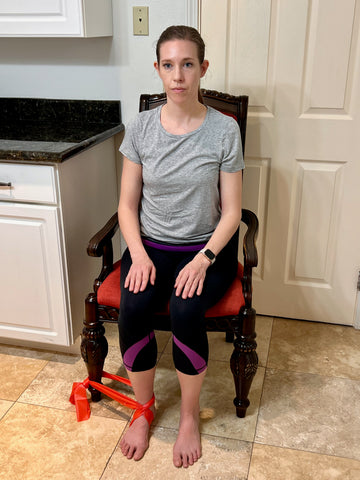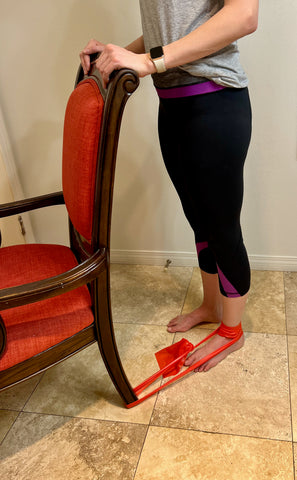Your Cart is Empty
🎁 Holiday Sale | 15% Off Almost Everything | Use code HOLIDAY15 at Checkout 🎁
🎁 Holiday Sale | 15% Off Almost Everything | Use code HOLIDAY15 at Checkout 🎁
Shop
Products
Modifications & Progressions for OTAGO Falls Prevention Exercise Program
August 08, 2024 8 min read

Modifications and Progressions for OTAGO Exercise Program
The Otago Exercise Program is designed for the prevention of falls in at-risk populations. We have created here aseries of modifications and progressions for the exercises in the program.
- Use the adaptations if you don’t have ankle weights, but do havebands.
- Use the progressions if you are looking for a bit more of a challenge with the existing program.
Parameters should stay the same from theoriginalprogram.
Track and document what exercises you do using the exercise calendar at the bottom of this document, or within the original program. Take note if you find that exercising at certain times of the day feels better than others.
WALKING
Daily walks are part of the original program - continue with those or build more exercise within the day-to-day. Try walking a bit further than normal, this could be walking to a store, getting off of the bus stop early or changing your routine to go for a walk when meeting friends. Walking is a great source of exercise with many benefits such as increasing general mobility, improving mood, encouraging social interactions and increasing non-exercise thermogenesis. If it is cold and icy, or very hot outdoors walking in a mall or on an indoor track may be a better option.
Try a warm up; marching knees high, marching knees low, or swinging the arms are all good ways to get blood flowing and joints moving. Keep your movements smooth and controlled.
Get a downloadable PDF of these Modifications and Progressions HERE
STRENGTHENING EXERCISES-Band Adaptation
Figure of 8 Wrap
The Otago Exercise Program indicates using aband if you don’t have access to adjustable ankle weights. To prevent the band from rolling up the foot, ankle or leg create a figure of 8 with the band around the ankle. Below is an illustration of how to position it for any exercise where the leg is moving forward. Adjust as needed to work with backward and sideways movements.




Front Knee Strengthening Exercise (Quadriceps)
Loop the band around your ankle in a figure of 8 (see photo above) and attach to the chair leg.
Sit in the chair with your back well supported.
Straighten leg out with toes flexed (toes towards your nose), think of lifting up your knee cap.
Lower the leg with control.
Repeat for a total of 10 repetitions 2 sets both legs.


Seated Hamstring Curl
Seated in a chair with a band around your ankle in a figure of 8 and the band attached to a sturdy object in front of you.
Have slight tension on the band with the leg straight in front of you with the heel on the floor.
Bend your knee and pull the band tight below you.
Repeat this exercise for 10 repetitions and 2 sets.
Hint: watch the alignment of your knee, try to keep everything in a straight line.


Back Knee Strengthening Exercise (Hamstring Curl) - Standing
Loop the band around your ankle in a figure of 8 (see photo) and attach the band to the chair or onto a table.
Bend the knee, and bring the foot toward your buttocks keeping your foot flexed.
Straighten your knee slowly and return to the starting position.
Repeat for a total of 10 repetitions and 2 sets each side.
Hint: keep your body upright and knees level with each other. Try not to hinge forwards at the hips.


Side Hip Strengthening Exercise (Hip Abductors)
Attach one end of the band to your ankle with a figure of 8 and the other to a sturdy surface like the leg of a table. This can also be done by looping the band around the base of the supporting foot and the working foot.
Stand tall and hold onto an object for support.
Kick the leg out sideways keeping the toe facing forward.
Return the leg to the starting position with control.
Complete 10 repetitions and 2 sets each side.
Hint: Try different foot positions, forward, slightly turned in and slightly turned out as your hip range of motion will allow you to target different parts of the glutes.


Monster walks (Hip abductors)
*You need to be comfortable side stepping without resistance, while sustaining balance and be able to clear the floor with your steps before you attempt this exercise.
Loop the band into a circle and step into it so it goes around the bottom of the foot.
Standing tall with a slight bend to the knee.
Step out sideways with the right foot, follow with the left and repeat for 10-15 steps, repeat the other direction. Keep your toes facing forward.
Hint: keep your head up and your eyes focused forward, place your hands on your hips or have them in front of you.


Seated Banded Calf Raise
This exercise can be done on a couch with foot on an ottoman or coffee table or while seated on a bed, you do not need to sit on the floor.
Wrap a band around the ball of your foot.
Push the toes down like a gas pedal into the band, watching your ankle alignment.
Slowly return to your starting position with control.
Complete 10 repetitions 2 sets each side.
Hint: progress by increasing the difficulty of the band or increase the number of repetitions to 20. Watch the alignment of the foot, try to keep the foot squared through the entire movement.


Calf Raises (Calves)
Stand tall facing a table.
Hold onto the table and look ahead.
Have your feet shoulder width apart.
Rise up onto your tiptoes.
Lower your heels to the floor with control.
Complete 10 repetitions 2 sets.
Progressions: to make it easier, increase the distance between legs and don’t come up as high. To make it more difficult you can bring your feet close together or perform with one foot. Alternatively you can go from two hand support to finger tip support to one hand support to finger tip support to hovering the hands over the support surface (see below), to completely unsupported (see below). Keep ankles strong and in alignment, you can hug a Bender ball between your ankles to help keep the alignment
Progression - Finger Tip Support


Progression - Hand Hovering


Progression - Unsupported


Toe Raise - Hold Support
Stand up tall, feet hip width apart beside a table or stable surface.
Hold on with two hands and keep head up eyes focused ahead.
Transfer your weight backwards and lift your toes up off the floor.
Lower the feet back to the floor with control.
Complete 10 repetitions and 2 sets.
Progressions: Reduce base of support by bringing legs and feet together, you can place a ball, folded towel or foam under the ball of the foot and push down and squish it with the ball of the foot. Avoid if you have any bone spurs in the heels or if you have balance issues such that you're prone to toppling backwards. You may also progress this exercise by going to fingertip support, hands hovering or no support (see below).
Progression - Finger Tip Support


Progression - Hands Hovering


Progression - Unsupported


BALANCE EXERCISES
Knee Bends - Squats, no support
Stand up tall near a table or support.
Place your feet around shoulder width apart - have toes slightly turned out.
Sit your hips back like you are going to sit in a chair.
Drive through your glutes to come back up into a standing position.
Have your hands on your hips or have your arms in front of you.
Complete 10 repetitions and 2 sets.
Progression: You can play around with foot distance to make this exercise easier or more challenging. You can also try to do the exercise on a foam balance pad, or on a pillow, cushion or towel (see below).
Progression - No Support or Chair


Progression - Unstable Surface


Walking and Turning Around
Walk forward in a figure of 8 motion at a normal pace.
Keep your head up and your eyes forward.
Progression: walk backward in the same pattern. Note: this is only to be done if you have good balance and the area you are walking in is clear of all objects, debris and tripping hazards including pets and children. Be sure to keep your weight forward when walking backwards and that you pick up your feet between steps.



Heel-Toe Walking - Unsupported
Stand up tall near a wall or a table.
Keep your hand floating just above the support surface, with eyes focused forward and chin level with the floor.
Place one foot directly in front of the other so that the feet make a straight line.
Complete for 10 steps before turning around and repeat for a total of 4 times.
Progression: to make this more challenging than you can do the same pattern but only go backwards, try this holding onto a surface then progress to hand floating to walking in the middle of the floor.

Heel Walking - Unsupported
Standing tall beside a table or along a wall.
Float your hand above the surface and look forward.
Transfer weight back just enough to lift your toes off of the floor, your knees will have to be straight.
Walk 10 steps forward on your heels, lower your toes back to the floor to turn around.
Complete 10 steps 4 times.
Progression: Heel walk in the middle of the space with no supports, attempt to walk backwards on your heels with support, hand floating and finally no support. The final progression would be to walk forward 10 steps on heels then immediately walk backward for 10 steps on heels without turning around.


Toe Walking - Unsupported
Standing tall beside a table or along a wall.
Float your hand above the surface and look ahead.
Rise up onto your tip toes and begin to walk forward.
Complete 10 steps forward before lowering down to turn around and rise up and repeat for a total of 4 times.
Progression: move to the center of the room with no supports, you could also progress to supported toe walking backwards, floating support toe walking backwards and unsupported toe walking backwards. Please note there are certain conditions including neurological conditions that are not appropriate for backward walking supported or not.


Single Leg Stand
Stand near a sturdy surface with your hands floating just above the surface, stand on one leg for 10 seconds.
To make it harder, close your eyes - you may need to go to fingertip support for this, switch legs and attempt another 10 seconds. Take note which side is harder, progress by trying to hold a single leg stance for longer.
Progression: This exercise may be made more challenging by standing on a foam pad, folded towel (see below) or pillow, try two feet to make sure that you are comfortable balancing then reduce to single stance supported, single stance finger tip (see below) and finally hands floating (see below).
Progression - Fingertip Support

Progression - Unsupported

Progression - On Unstable Base, Fingertip Support

Progression - Unstable Base, Unsupported

The success factor for any exercise program is consistency, try to get to these exercises at least three times a week. Track your activity using the calendar below. Make a note of how many you did and attempt to beat that number the next time you exercise. Focus on form, if you find that you are struggling to complete the suggested number of repetitions. You can try these exercises on their own or as substitutions for exercises that are already within theOTAGO program.
Always seek advice from your medical professional prior to starting an exercise program to make sure that it is right for you. Not all exercises will be appropriate for all populations, please work within your own parameters of what your body can handle at the time.

Subscribe
Sign up to get the latest on sales, new releases and more …

